Back to: Sandy Red Sea Reef Slope 1 of
5, On to: Sandy Red Sea Reef Slope 3 of
5
|
Species Offered Occasionally from Sandy Red Sea
Reef Slopes but Should be Avoided
|
| The Bluespotted Stingray, Taeniura lymna.
Very rarely lives for any time in captivity; dying from cumulative
stress and trauma from collection, holding, shipping... and
infection from inappropriate aquarium habitat... Only for those
with very large, open-bottomed systems with fine substrate, the
patience and skill to pick out an initially healthy specimen. |
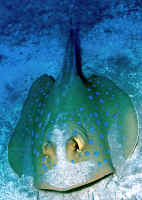 |
| Crocodilefishes, family Platycephalidae.
Related to Scorpionfishes, though only commonality for aquarists is
their penchant for swallowing tankmates. Nine species are found in
the Red Sea. The most common is pictured: Papilloculiceps
longiceps. Occasionally sold in the hobby, should be
avoided. |
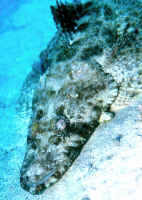 |
| The Fourline Wrasse, Larabicus
quadrilineatus is sold in the trade every now and then. It is
beautiful, and does stay small (maximum length about four
inches/ten cm.), but though it's relatively hardy and a real
asset as a non-obligate cleaner as a juvenile, as adults they feed
primarily on coral polyps. Shown: juvenile and adult. |
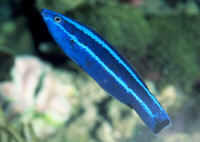 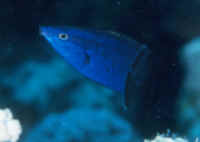 |
| "Touchy" Wrasses of the genera
Macropharyngodon (M. bipartitus from here)<right> and
Anampses (A. twistii, A. meleagrides, and rarely A.
lineatus)<below> are offered from the Red Sea, and almost
always perish; from capture, shipping trauma, starvation. |
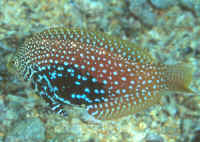 |
|
The common or Blue Cleaner Wrasse, Labroides
dimidiatus . Thousands will be collected today and thousands
will die. One out of thousands lives for a year in captivity.
Indo-Pacific, east Africa, Red Sea to the Marquesas. To four and
a half inches in length. Juvenile in the Red Sea, adult, for a
short while, in captivity, and a pair working over a Parrotfish
"customer" at their cleaning station in the Red
Sea.
|
| Ultimately too large and aggressive Triggerfishes,
particularly the Blue Triggerfish, Pseudobalistes fuscus,
where the Red Sea is concerned. This fish is gorgeous and
"medium" aggressive as a juvenile, but grows to twenty
two inches in length not counting the tail in the wild. Shown:
Juvenile and adult. |
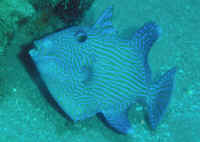 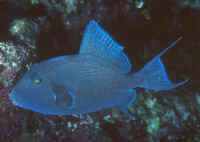 |
| Nudibranchs like the common
Chromodoris quadricolor Ruppell & Leuckart 1828. Red
Sea, eastern Africa... To 4.5 cm. in length. Very frequently starve
to death in captivity. Here in the Red Sea. |
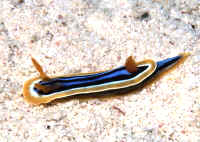
|
| Hymenocera pictus Dana 1852, the Harlequin
Shrimp. Anterior first pair of legs look like tweezers, second pair
covering them. First antennae flap-like... waved around side to
side. Live in pairs only. Noted for their feeding exclusively
on echinoderms; starfish and urchins. |
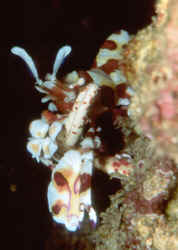
|
| Pincushion Sea Star, Choriaster granulatus,
is a big, bulky Indo-Pacific asteroid that scavenges in reef
shallows. It should only be employed in systems of hundreds of
gallons size. |
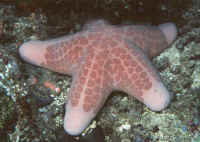
|
| Leopard Blenny, Exallias brevis.
Indo-Pacific; Red Sea to Hawaiian, Marquesan Islands. To almost six
inches in length in the wild. Obligate feeders on live coral
polyps. Still offered on pet-fish markets on occasion. Definitely
NOT reef safe. This male in Oahu, Hawai'i. |
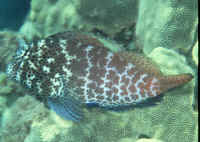
|
Survey of Best, Available Species of
Sandy Red Sea Reef Slopes:
Algae: a few scattered Red algae species are found this deep
down, mostly encrusting types.
| Turbinaria sp. A Brown
Algae of Phylum Heterokontophyta, Order Fucales,
Family Sargassaceae. Hawai'i,
Red Sea close-up image. |
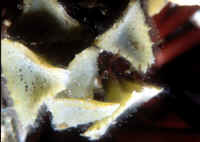
|
Sponges, Phylum Porifera.
| Are largely cryptic here (hidden, part of the
inside, underside of rock, coral-stone, though some occur
occasionally as large colonies of near to adult size. Shown: a
Siphonochalina species of about two foot height. |
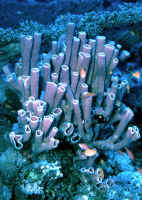
|
Stinging-Celled Life, Phylum Cnidaria: There is a smattering
of stony corals, gorgonians, the occasional sea anemone, but the hard
surfaces of the sandy reef slope here are overwhelmingly dominated by
Pulsing Corals of the family Xeniidae (likely ninety some percent of
cnidarian presence), with the bulk of the remainder various sized
stands of the hydrozoan Millepora, Fire Coral.
| Several species of Xenia (X.
umbellata shown), Heteroxenia fuscescens (shown) and
Anthelia glauca (shown) occur on hard surfaces of the reef
slope proper in calmer water settings, and are predominate on stony
substrates on the Sandy Reef Slope. |
Back to: Sandy Red Sea Reef Slope 1 of
5, On to: Sandy Red Sea Reef Slope 3 of
5
|
|

